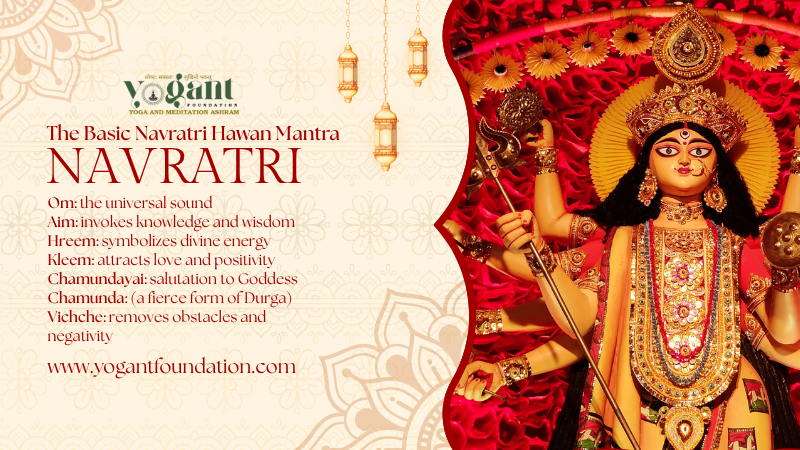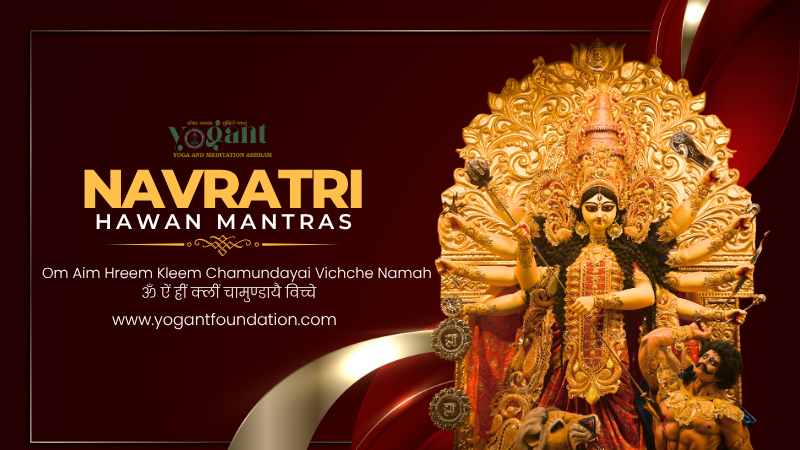Introduction: The spiritual essence of Navratri
Navratri is one of the most celebrated Hindu festivals. It’s more than dancing, colours, and fasting. Navratri is a journey of faith – a worship for goddess Durga in her many forms. Hawan is a sacred fire ritual that takes place during Navratri. [Navratri Hawan Mantra]
Hawan, the act of offering ghee and herbs into a sacred flame, symbolizes purification and devotion. Hawan is even more powerful when performed during Navratri. The Navratri Hawan Mantras are a powerful way to invoke the energy and vibrations of Maa Durga.
We will look at the Navratri Hawan Mantra and their benefits. You can also learn how to do them yourself or in temples. It doesn’t matter if you are a seasoned Hindu or just starting to learn about Hindu traditions. This guide will connect you with the Divine energy of Navratri.
What is Navratri Hawan ?
Hawan (also known as Homa) is a Vedic ritual that is performed while chanting mantras. Fire is a purifier as well as a carrier of our prayers.
Hawan, a devotional ritual performed during Navratri in honour of Maa Durga (and her nine manifestations):
Shailputri
Brahmacharini
Chandraghanta
Kushmanda
Skandamata
Katyayani
Kalratri
Mahagauri
Siddhidatri
Every day is unique and has its own energy. And the Navratri Hawan Mantras that are chanted during this time amplify and cleanse the spiritual aura. They also bring divine protection.
Importance of Navratri Hawan Mantra
Fire Purification– The flames cleanse not only your environment but the inside of you, as well. They remove negativity and tension.
Divine Energy– Mantras used during Hawan bring Goddess Durga to the sacred area.
The Fulfilment Of Wishes– Navratri has been considered to be an auspicious period for manifesting desires and requesting blessings of health, wealth, and happiness.
Negativity Protection– The energy generated by Hawan is a protective shield from evil influences and forces.
Calm Mind– The sound of the crackling fire, combined with a rhythmic mantra chant, is calming to the Mind.
Navratri Hawan Mantras – Their Power and Meaning
Mantras do not consist only of words. They are also vibrations in sound that connect us to cosmic energies. The power of each Navratri Hawan Mantra varies.

1. Basic Navratri Mantra
Hawan is most commonly chanted with the following mantra:
“Om Aim Hreem Kleem Chamundayai Vichche Namah”
- Om- the universal sound
- Aim– invokes wisdom and knowledge
- Hreem– symbolises divine energy
- Kleem- attracts positivity and love
- Chamundayai– Salutation to the Goddess Chamunda, a fierce version of Durga
- Vichche– removes negatives and obstacles
This mantra will be repeated repeatedly throughout the Hawan. It brings strength, courage, and blessings.
2. Mantras for Each Day of Navratri
The day after each Navratri falls on a particular form of Maa Durga. Hawan involves chanting the appropriate mantras.
Day 1 – Shailputri
“Om Devi Shailputryai Namah”
Day 2 – Brahmacharini
“Om Devi Brahmacharinyai Namah”
Day 3 – Chandraghanta
“Om Devi Chandraghantayai Namah”
Day 4 – Kushmanda
“Om Devi Kushmandayai Namah”
Day 5 – Skandamata
“Om Devi Skandamatayai Namah”
Day 6 – Katyayani
“Om Devi Katyayanyai Namah”
Day 7 – Kalratri
“Om Devi Kalratryai Namah”
Day 8 – Mahagauri
“Om Devi Mahagauryai Namah”
Day 9 – Siddhidatri
“Om Devi Siddhidatryai Namah”
As the Hawan is being performed, the mantras will be repeated.
How to Perform Navratri Hawan Mantra at Home
Hawan, which is performed at the mosque by priests only, can be performed with sincerity and devotion. A simple guide is provided below:
Materials Required:
- Havan Kunds (fire Pits)
- Pure cow Ghee
- Camphor and wood pieces will ignite a fire
- Samagri, an herbal mix, is available at stores
- A Ladle or Spoon to Offer Offerings
- Navratri Hawan Mantras written down
Navratri Hawan Mantras: Steps for Performer
Cleanse Yourself, and the Space
Set up your Havan Kund with the east-facing side.
Lighting the Fire
To ignite the Havan Kund, use camphor or ghee.
Invoke Maa Durga
Fold your hands and close your eyes to invite Durga in.
Chant Mantras
To remove obstacles, begin with ‘Om Ganeshaya Namah’ and then the Navratri Mantras.
Make Offers
As you sing “Swaha”, add ghee or samagri to the fire.
Aarti Conclude
Durga Aarti: Pray for health, prosperity, and peace.
Benefits of Chanting Navratri Hawan Mantras
Peace of Mind and Focus- Mantras to calm restless thoughts and bring peace of Mind.
Growing Spiritually- Regular Chanting helps you to grow spiritually.
The Prosperity of Families- Hawan promotes peace and harmony in families.
Positive aura– The sound and vibrations from the fire will cleanse your environment.
Health– Hawan smoke purifies the air and kills bacteria. This creates an environment that is healthy and hygienic.
Navratri Hawan Mantra in Temples vs. Home
- In temples– Performed by priests using full Vedic Rituals to attract large groups of devout devotees. These collective prayers are very potent.
- At home– More intimate and personalized, creating an atmosphere of spirituality for your family. It is possible to have a powerful Hawan by simply having faith.
Modern Relevance of Navratri Hawan Mantra
People often consider rituals old-fashioned in our fast-paced world. Hawan isn’t just about tradition; it is also deeply scientific.
- Purification of the Air– The herbs that are used to make samagri purify the air.
- Relaxation– Chanting mantras can reduce anxiety and increase focus.
- Eco-friendly Ritual– Hawan, unlike loud parties or fireworks, is an environmentally-friendly and natural practice.
Navratri Hawan, then, is an amalgamation of spirituality with wellness and cultural preservation.
FAQs on Navratri Hawan Mantra
Q1. Can I perform Navratri Hawan Mantra without a priest?
With devotion and sincerity, you can easily perform the Hawan in your home by using some basic mantras.
Q2. When is the best Navratri Hawan time?
The ideal time to visit is either early in the morning (Brahma muhrta) after sunset or late at night.
Q3. What is the correct number of times to recite the Navratri hawan mantra?
It is considered auspicious to repeat the mantra 108 times; however, 11 or even 21 times with full faith will be effective.
Q4. Is it possible to use a Havan Kund instead of the steel bowl?
You can, yes, use a fire-resistant vessel if you don’t own a Kund.
Q5. Hawan is compulsory for Navratri?
No obligation, but very beneficial. It is beneficial to listen to Mantras or attend a temple Hawan.
Conclusion – Awakening the Divine Within
Navratri means more than just rituals. The goal is to awaken your inner strength. The mantras of the Navratri Hawan do not possess magical power, but instead create vibrations that align you to Maa Durga’s divine energy.
Hawan, performed in devotion whether at home or in the temple, can help you to overcome negativity.
Then, during this Navratri season, you can light a sacred fire and sing the Navratri Hawan Mantras. You will also receive the blessings of Goddess Durga.



